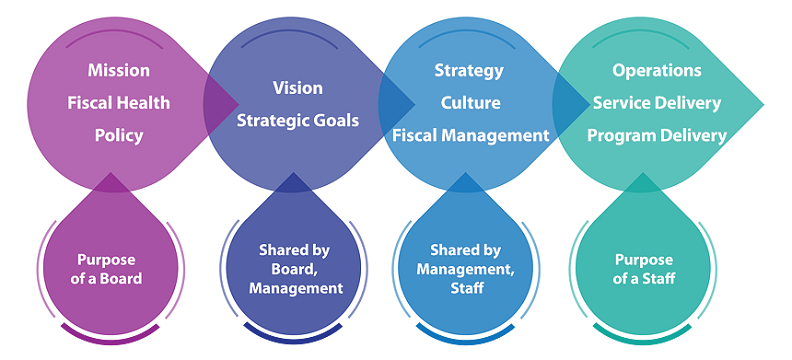
Board members are the backbone of every successful nonprofit, their efforts laying the groundwork for impactful and lasting contributions to the community. Thus, understanding the dynamics of a nonprofit board, along with the challenges they often face, is vital in forming an effective team that can drive the organization forward. Here we provide clear insight into the nature of nonprofit entities, the legal and ethical duties shouldered by board members, and the pivotal role a board plays in guiding a nonprofit’s mission.
Contents
Understanding Nonprofit Organizations
Before getting into the role of the board in a nonprofit organization, it is crucial to understand what a nonprofit organization is and how it differs from for-profit entities. This understanding provides a foundation for comprehending the importance of the board and its unique responsibilities in nonprofit management.
Brief Overview of Nonprofit Organizations
Nonprofit organizations, also known as not-for-profit entities, are institutions established with a primary goal of providing a service or advancing a particular social cause rather than making a profit for its owners or shareholders. These organizations can operate in various areas, including but not limited to, education, health, environment, arts and culture, and social services.
Unlike profit-driven corporations, nonprofits reinvest any surplus funds back into their mission. Their primary purpose is not to distribute earnings to stakeholders but to further the objectives for which the organization was established.
Purpose and Mission of Nonprofits
The purpose of a nonprofit organization is defined by its mission statement, which is a clear and concise expression of the organization’s core objectives and goals. The mission guides the direction of the organization, influences strategic decisions, and serves as a roadmap for achieving its intended social impact.
For example, a nonprofit organization dedicated to environmental conservation may have a mission to protect natural habitats and educate the public about the importance of biodiversity. A health-focused nonprofit might aim to advance medical research or provide healthcare services to underprivileged communities. The mission of a nonprofit lies at the heart of its operations and shapes its programs, initiatives, and community interactions [1].
Difference Between Nonprofit and For-Profit Entities
Although both nonprofit and for-profit organizations may provide services or products, their fundamental structures and objectives differ significantly.
For-profit entities are primarily driven by generating profits for their owners or shareholders. They aim to increase their revenue and reduce costs, and profits earned are often distributed among shareholders in the form of dividends.
On the other hand, nonprofit organizations are driven by a cause or a mission. They aim to serve their communities, advance their causes, or bring about social change. Unlike for-profit entities, any surplus earnings in nonprofits are not distributed to owners or shareholders but are reinvested into the organization to further its mission.

The Role of the Board in a Nonprofit
With a solid understanding of nonprofit organizations and their mission-driven nature, we can now turn our attention to the heart of this post: the role of the board in nonprofit management. Nonprofit boards play a vital role in ensuring that the organization stays true to its mission, maintains fiscal responsibility, and operates within legal and ethical boundaries.
Board Members: Who Are They?
A nonprofit board typically consists of a group of individuals who volunteer their time, skills, and resources to guide the strategic direction of the organization. Board members come from a variety of backgrounds, bringing diverse skills and perspectives that can benefit the organization. They may include professionals from various industries, community leaders, experts in the nonprofit’s area of work, and even beneficiaries of the nonprofit’s services.
It’s important to note that while board members are often volunteers and not employees of the nonprofit, they hold significant responsibilities and play an integral role in the organization’s success. Their position goes beyond mere advisory capacity, and they are legally responsible for the governance of the nonprofit.
Legal and Ethical Duties of Board Members
Board members are bound by several legal and ethical duties that govern their actions and decisions in relation to the nonprofit. These include the duty of care, the duty of loyalty, and the duty of obedience.
The duty of care requires board members to make decisions in good faith and in the best interest of the organization, exercising the same level of care and diligence as would be expected in their own personal affairs.
The duty of loyalty mandates that board members prioritize the interests of the nonprofit above their own personal or professional interests. This duty implies avoiding conflicts of interest and ensuring confidentiality of the nonprofit’s sensitive information.
Lastly, the duty of obedience necessitates board members to ensure that the nonprofit complies with the law, follows its bylaws, and adheres to its mission. This includes compliance with federal and state regulations governing nonprofit operations, as well as regulations specific to the nonprofit’s field of work [2].
Importance of the Board in Guiding the Nonprofit’s Mission
A nonprofit board is essential in steering the organization towards its mission. The board shapes the organization’s strategic direction, aligns resources to achieve mission-related goals, and monitors the organization’s performance in fulfilling its mission.
The board ensures that all activities, programs, and initiatives align with the organization’s mission, and that they are creating the intended impact. This alignment helps to maintain the organization’s credibility, integrity, and reputation, and is key to its success and sustainability.

Key Functions of the Nonprofit Board
The board of a nonprofit organization serves multiple functions that are crucial to the organization’s success. These functions fall primarily into three categories: governance, financial oversight, and performance management. Understanding these key functions can provide valuable insight into how a nonprofit board operates and its central role in nonprofit management.
Governance
Governance is one of the board’s primary responsibilities. It involves setting the organization’s strategic direction, making critical policy decisions, and ensuring the organization’s activities align with its mission.
Defining Mission and Purpose
The board plays a key role in defining the organization’s mission and purpose. This involves crafting a clear, compelling mission statement that encapsulates the organization’s goals and serves as a guide for its activities. The board must ensure that the mission remains relevant over time, revising it as necessary to reflect changing societal needs or organizational capabilities.
Strategic Planning and Policy Making
Beyond defining the mission, the board is also responsible for strategic planning. This entails setting long-term goals and creating a roadmap for achieving them. The board works closely with management to develop strategic plans that align with the organization’s mission and maximize its social impact [3].
In addition, the board creates and revises key policies that govern the organization’s operations. These policies may relate to issues such as conflict of interest, financial management, human resources, and program activities.
Financial Oversight
Financial oversight is another critical function of the board. It involves monitoring the organization’s financial health, approving budgets, and guiding fundraising efforts.
Budget Approval and Monitoring
The board is responsible for reviewing and approving the organization’s annual budget. This budget outlines the organization’s projected income and expenses, serving as a financial plan for the upcoming year. The board must ensure that the budget aligns with the organization’s strategic goals and that it is fiscally responsible.
In addition to approving the budget, the board also monitors the organization’s financial performance throughout the year. This involves reviewing financial reports, tracking actual income and expenses against budget projections, and making adjustments as necessary.
Fundraising Strategy and Implementation
Fundraising is a key part of most nonprofits’ operations, and the board plays a crucial role in this area. The board helps to develop fundraising strategies, identify potential sources of funding, and participate actively in fundraising activities. Board members may also leverage their personal and professional networks to attract donors and sponsors.
Performance Management
Performance management involves monitoring the organization’s performance towards its goals and managing the performance of the chief executive.
Hiring and Evaluating the Chief Executive
The board is responsible for hiring the chief executive (often called the Executive Director or CEO) who manages the day-to-day operations of the organization. This involves defining the role, recruiting candidates, conducting interviews, and making the final hiring decision.
Beyond hiring, the board also evaluates the chief executive’s performance on a regular basis. This typically involves assessing the executive’s leadership, management skills, and ability to achieve organizational goals. The results of this evaluation often inform decisions about the executive’s compensation and continued employment.
Setting Executive Compensation
The board sets the compensation for the chief executive. This involves determining a fair and competitive salary and benefits package that reflects the executive’s responsibilities and performance. The board must ensure that the compensation is reasonable and justifiable, given the organization’s size, complexity, and financial capacity [4].
Assessing Organizational Performance
Lastly, the board assesses the organization’s overall performance towards its mission and strategic goals. This involves reviewing program outcomes, measuring social impact, and determining whether the organization is making progress towards its mission. The board uses this information to guide strategic planning and decision-making.

Building an Effective Nonprofit Board
Understanding the board’s key functions is the first step, but creating a board that can effectively carry out these responsibilities is another matter entirely. Building an effective nonprofit board requires careful planning, strategic recruitment, and ongoing board development efforts.
Recruiting the Right Board Members
The first step to building an effective board is recruiting the right members. The board should consist of individuals who are passionate about your nonprofit’s mission, and who bring a diverse mix of skills, experience, and perspectives to the table.
When recruiting board members, consider the specific needs of your organization. Do you need financial expertise to strengthen the board’s oversight role? Are you looking for individuals with strong community connections to boost fundraising efforts? Could your board benefit from someone with legal knowledge to help navigate regulatory complexities? By identifying these needs, you can seek out individuals who fill these roles.
It’s also important to look for individuals who are committed to the responsibilities of board membership. Serving on a nonprofit board is a significant commitment of time and energy, and prospective members should be prepared to fulfill their duties diligently.
Orienting and Training Board Members
Once you’ve recruited the right individuals, it’s crucial to provide them with the training and information they need to be effective board members. An orientation program for new members is an excellent way to introduce them to the nonprofit’s mission, programs, and operations, as well as the board’s responsibilities and expectations.
Ongoing training and development are also essential. Board members should be kept up-to-date with developments in nonprofit governance, fundraising strategies, legal regulations, and other relevant areas. This can be achieved through regular training sessions, attending relevant workshops or conferences, or providing resources for self-directed learning.
Fostering Board Engagement and Participation
Engaged board members are more likely to contribute effectively to the board’s work. To foster engagement, encourage active participation in board meetings and involve board members in committee work or special projects that align with their interests and skills. Also, ensure that board meetings are well-structured and productive, with clear agendas and sufficient time for discussion and decision-making.
Open communication is another key to board engagement. Board members should feel comfortable expressing their ideas, asking questions, and raising concerns. Regular updates about the organization’s activities and performance can also help board members feel connected to the nonprofit’s work and understand the impact of their contributions.
Maintaining Diversity and Inclusion
Diversity and inclusion are essential for an effective nonprofit board. A diverse board, in terms of race, gender, age, skills, experience, and perspectives, can enhance the board’s decision-making, creativity, and problem-solving abilities. It can also improve the board’s understanding of the communities the nonprofit serves and enhance the organization’s credibility and reputation.
To promote diversity and inclusion, implement fair and transparent recruitment practices, ensure an inclusive board culture where all members feel valued and heard, and regularly assess the board’s composition and performance in this area.
Challenges Faced by Nonprofit Boards and How to Overcome Them
Even with the most dedicated and skilled individuals on board, nonprofit boards may still encounter challenges. Recognizing these potential obstacles and proactively addressing them can significantly enhance a board’s effectiveness and the organization’s overall success.
Managing Board Turnover
Board turnover is a common challenge for many nonprofits. When board members leave, the organization can lose valuable knowledge and experience. High turnover can also lead to a lack of continuity in leadership and strategic direction.
To manage board turnover, it’s essential to have a succession plan in place. This plan should outline the process for identifying potential board leaders and preparing them for their roles. Regular board evaluations can also help identify any issues that may be leading to turnover, such as board member dissatisfaction or lack of engagement [5].
Also, consider implementing term limits for board members. While this may seem counterintuitive, term limits can help ensure fresh perspectives and ideas, prevent board stagnation, and provide a structured and predictable transition process.
Ensuring Active Engagement
Another common challenge is ensuring active engagement of all board members. Board members may become passive if they feel their input is not valued or if they are not clear about their roles and responsibilities.
To overcome this, clarify board member roles and expectations right from the start. Regularly remind board members of their duties and the importance of their active participation. Provide ongoing training and development opportunities to equip board members with the knowledge and skills needed to contribute effectively.
Also, ensure open and transparent communication within the board. Encourage board members to share their ideas, ask questions, and voice any concerns. Make board meetings interactive, with ample opportunities for discussion and input from all members.
Balancing Fundraising and Governance
Nonprofit boards often struggle with balancing their fundraising responsibilities with their governance duties. While fundraising is a critical function of the board, it should not overshadow the board’s role in strategic planning, policy-making, and oversight.
To achieve this balance, clearly delineate the board’s fundraising and governance responsibilities. Ensure that board meetings and activities allocate sufficient time and attention to both areas. Provide training and resources to help board members understand and fulfill their governance duties.
Also, consider setting up separate committees for fundraising and governance. This can help ensure that both areas receive the attention they need and allow board members to focus on their areas of interest or expertise.
Conflicts of interest can pose significant challenges for nonprofit boards. These occur when a board member’s personal or professional interests could potentially interfere with their ability to make impartial decisions for the nonprofit.
To navigate this, establish a robust conflict of interest policy. This policy should require board members to disclose any potential conflicts of interest and outline procedures for managing these situations. Ensure that all board members understand and adhere to this policy.
References
[1] A Nonprofit Board of Directors – What is a Board?
[2] Nonprofit Board Roles and Responsibilities
[3] Board of Directors for Nonprofits
[4] The New Work of the Nonprofit Board
[5] Ten Basic Responsibilities of Nonprofit Boards
